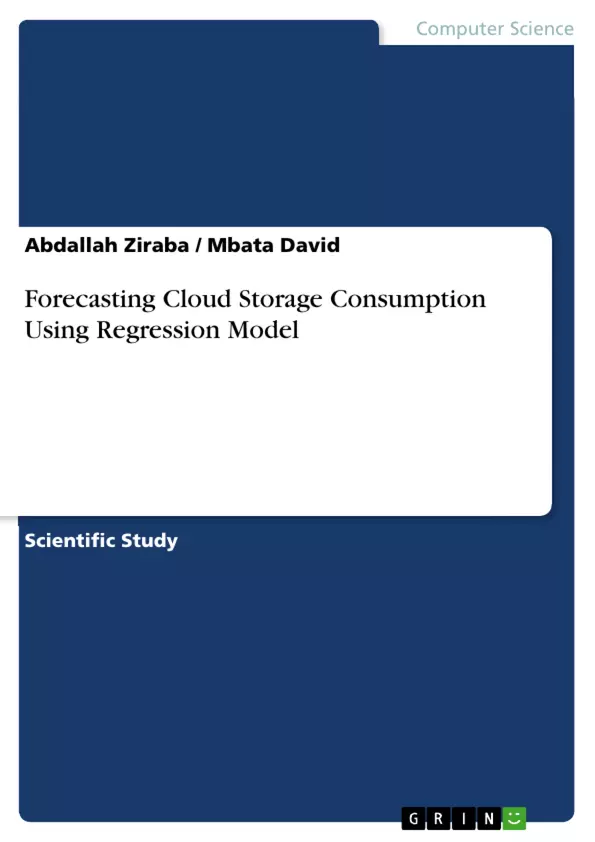The primary aim of the study was to develop a regression model for forecasting monthly cloud storage consumption. Second, to ascertain if the month is a reliable predictor of cloud storage capacity consumed. The model was developed using Minitab18 statistical software. The dependent variable was cloud storage capacity consumed, while the independent variable was the month of cloud storage consumption. The model was validated by checking the assumptions of regression to establish its suitability in making future predictions. Twelve-month data sets was analyzed to make future prediction for each passing month. The model made predictions with near accuracy from the actual cloud storage data consumed in each month. The model determines the intervals of monthly storage consumption. The study concluded that the month is a globally significant linear predictor of cloud storage capacity consumed over a period.
Inhaltsverzeichnis (Table of Contents)
- 1.0. Introduction
- 1.1. Background of the study
- 1.2. Problem statement
- 1.3. Objectives of the study:
- 1.4. Research hypothesis:....
- 2.0. Related works/ Review of related literature
- 3.0. Methods
- 3.1. Method and source of data collection
- 3.2. Sample size
- 3.3. Method of data analysis, procedure and instrument used for analysis..
- 3.4. The regression model.
- 3.5. Dependent and Independent Variable.
- 3.6. Validation of model
- 4.0. Analysis
- 4.1. Regression Equation
- 4.2. Discussion
- 4.3. Key findings.
- 5.0. Conclusion
- 6.0. References.
Zielsetzung und Themenschwerpunkte (Objectives and Key Themes)
This study aims to develop a regression model for forecasting monthly cloud storage consumption and to investigate whether the month itself is a reliable predictor of cloud storage capacity consumed. The model was developed using Minitab 18 statistical software and validated by checking the assumptions of regression to ensure its suitability for future predictions.
- Forecasting cloud storage consumption using a regression model
- Evaluating the month as a predictor of cloud storage capacity
- Developing and validating a regression model using Minitab 18
- Analyzing 12-month data sets to make predictions for future months
- Investigating the significance of the month as a linear predictor of cloud storage consumption
Zusammenfassung der Kapitel (Chapter Summaries)
The introduction delves into the significance of cloud computing and the need for accurate cloud storage forecasting in the context of increasing data generation from the internet of things (IoT). The study examines the cost implications of cloud storage and the challenges faced by organizations in understanding and managing cloud storage costs. The research objectives are outlined, focusing on developing a forecasting model and assessing the predictive power of the month. The study's research hypothesis is presented, outlining the relationship between changes in cloud storage capacity consumed and the month of consumption.
The chapter on related works provides a review of existing studies on cloud computing forecasting. It discusses the use of different regression models for predicting energy consumption in cloud data centers and the success of a server provisioning model for forecasting cloud server availability. The chapter highlights the limitations of existing models in predicting cloud storage consumption, particularly in determining the intervals of monthly consumption.
The methods section outlines the approach used to collect and analyze data, including the sample size, data analysis procedures, and the regression model itself. The chapter explains the dependent and independent variables used in the model and the process of model validation to ensure its reliability for future predictions.
Schlüsselwörter (Keywords)
This study focuses on the crucial topics of cloud computing, forecasting, storage capacity, regression modeling, and data analysis. It uses Minitab 18 software to develop and validate a model for predicting monthly cloud storage consumption, exploring the significance of the month as a linear predictor of storage capacity consumed.
- Citation du texte
- lecturer Abdallah Ziraba (Auteur), Mbata David (Auteur), 2017, Forecasting Cloud Storage Consumption Using Regression Model, Munich, GRIN Verlag, https://www.grin.com/document/413003



